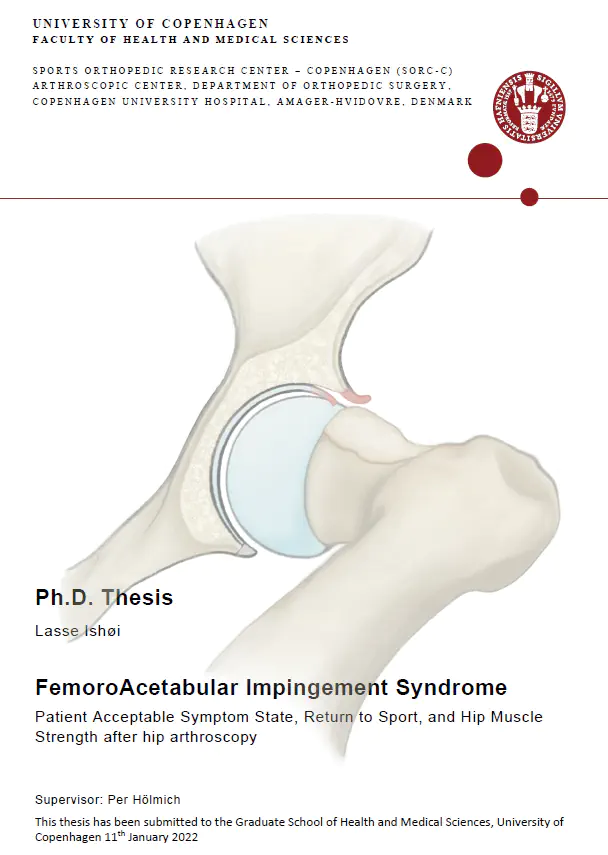Explore and download PhD Thesis

Abstract
Introduction
Hip-related pain is a leading burden of disability globally. Femoroacetabular impingement syndrome is a cause of hip-related pain typically diagnosed in young to middle-aged physically active individuals. It is caused by altered hip joint morphology (i.e., the shape of the bones), which, in the middle-aged to elderly, has been linked to the development of osteoarthritis. Femoroacetabular impingement syndrome is often treated surgically using an arthroscopic procedure. While hip arthroscopy effectively alleviates pain and improves function, less is known about how patients consider their function after surgery and whether factors before surgery can help predict the outcome. In this thesis, you will find five papers with the overarching aim of investigating 1) the influence of hip joint morphology as a precursor for early osteoarthritis, 2) subjective and objective outcomes after hip arthroscopy for femoroacetabular impingement syndrome, and 3) if factors before surgery can help predict how patients end up after surgery.
Methods
We first investigated the associations between different characteristics of hip joint morphology with surgically defined hip cartilage injuries using data from the Danish Hip Arthroscopy Registry (Paper I). Second, we surveyed patients who had undergone hip arthroscopy for femoroacetabular impingement syndrome with regards to their current symptoms and sports function by asking whether they considered their symptoms as acceptable (141 patients, Paper II) and whether they were able to engage in their pre-injury sport (189 patients, Paper III). Subsequently, we measured objective function – hip muscle strength and jump performance – in 45 patients who had undergone hip arthroscopy for femoroacetabular impingement syndrome (Paper IV). Finally, we developed and externally temporal validated clinical prediction models to predict a successful or unsuccessful outcome after hip arthroscopy using data from the Danish Hip Arthroscopy Registry (1546 patients, Paper V).
Results
Specific hip joint morphologies were associated with distinct cartilage injury patterns. More severe morphology was associated with a higher risk (4-fold) of severe cartilage injuries. A little more than half of the patients rated their symptoms as unacceptable 1-2 years after hip arthroscopy, while 57 % were engaged in their previous sport activities, yet only 17 % had a performance level comparable to before the onset of hip and groin pain. No differences were found in maximal hip muscle strength or jump performance between the operated and non-operated hip 6-30 months after hip arthroscopy. However, the operated hip displayed less explosiveness for hip flexion. Furthermore, having higher hip extension strength was associated with being engaged in pre-injury sport. By using 26 clinical variables collected prior to hip arthroscopy, it was possible to accurately predict the risk of ending up with an unsuccessful outcome (having unacceptable symptoms) 1 year after hip arthroscopy.
Conclusions
In this thesis, we have provided an overview of the role of different bony hip joint morphologies for the risk of cartilage injuries, presented a detailed picture of what patients can expect after hip arthroscopy for femoroacetabular impingement syndrome, and developed and validated a clinical prediction model that can be used in clinical practice to guide if hip arthroscopy is beneficial for the patient. We show that the severity of cam morphology increases the risk of cartilage injuries, suggesting that cartilage injuries may be the underlying pathology in these patients. After hip arthroscopy, patients can expect to get better, but up to half of all patients continue to rate their symptoms as unacceptable, and only a few can resume sporting activities without hip and groin problems. By using a clinical prediction model based on typical clinical variables collected prior to surgery, the orthopedic surgeon can estimate the likelihood of the patient ending up with unacceptable symptoms one-year after surgery. This information can be used to guide the decision of whether hip arthroscopy is beneficial for the individual patient and, thus, can help improve hip arthroscopy outcomes in the future.